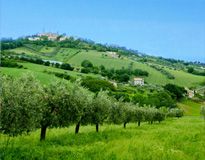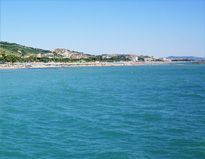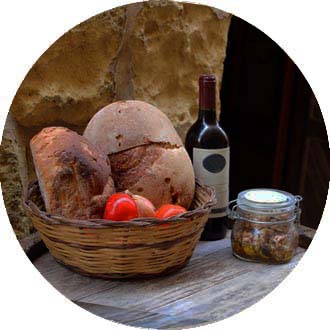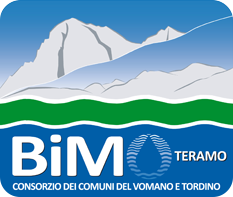It is the capital city of the province of Abruzzo more to the north of the region, located at the confluence of the river Tordino and the Vezzola stream, at 265 m s.l.m. and about halfway between the Gran Sasso and the Adriatic Sea. The territory of Teramo borders to the north with Campli and Bellante, to the south with Cermignano, Penna Sant'Andrea, Basciano and Montorio al Vomano, to the east with Canzano and to the west with Cortino and Torricella Sicura.
The current city of Teramo and its territory have been inhabited since ancient times and in pre-Roman times it was the capital of a people, the Pretuzio, to be conquered in 290 BC by the Roman consul Manio Curio Dentato becoming a municipality.
As capital city of the Pretutium it was inserted by Augustus in the V regio, afferente the Picenum, and knew a period of prosperity and expansion, witnessed by the building of temples, baths, theaters and other buildings important for the public and social life. In 410 it was sacked and razed to the ground by the Visigoths and then rebuilt in 568, while subsequently it was conquered by the Longobards and brought back to the Fermo marquisate and after the Duchy of Spoleto.
The vicissitudes of the city, however, did not end there. In 1155 it was again almost completely destroyed in the feud between the Normans and the dukes of Puglia but rose again and under the Episcopal government it experienced a new period of splendor and well-being, attested, among other things, by the construction of the new cathedral of Santa Maria Assunta.
In particular this positive phase lasted from 1202 to 1292, when the walls were enlarged, new churches were erected, including the current Church of Sant'Antonio, and the city was included in the portion of the Abruzzo Citra of the nascent "Giustizierato d ' Abruzzo "(1233). This period of progress continued with the Angevin domination, during which Teramo acquired castles, districts and important privileges by the sovereigns and also continued the work of urban expansion and architectural enrichment with the construction of churches, convents, palaces and other public buildings. valuable for civic and religious use.
In 1362, however, work began on the construction of Palazzo Melatino, a circumstance that gave the possibility to this powerful and influential family from Teramo to affirm its prestige on the city. The decline, however, came almost at the end of the fourteenth century, when there followed a series of unfortunate and even disastrous events that led Teramo to know a long phase of difficulty. The earthquake of 1380, the conflict between the family of the Melatini and the De Valle and the brigandage contributed decisively to the situation, which made the city sink into an evident decadence from which it did not recover even during the government of the lords of Altavilla, nor under the domination of the French and the Spanish.
During the sixteenth century the rivalry exploded and then a real conflict between Teramo and Atri, so that on November 17, 1521 the Dukes of Acquaviva di Atri besieged the city that knew how to resist and did not fall, unique in the district, also thanks to the appearance of San Berardo who forced the besiegers to retreat. Just in the sixteenth century Teramo began to flourish from the cultural point of view, thanks above all to the imminent historian Muzio Muzii who, in his Dialogues, will describe in a masterly way the great plague that struck Teramo in the middle of the 16th century. In addition to the work of Muzii, the opening of the first Teramana typography is also due to the Facij brothers.
But Teramo had to face other hard times. In 1703 the devastating earthquake that struck L'Aquila caused heavy damage even to Teramo that exacerbated an already hard situation due to rampant poverty and the cholera epidemic. The century ended with the bloody pillage perpetrated in 1798 by the French led by Napoleon Bonaparte during their conquest of Italy, while the following year, July 28, the city was hit by a new heavy earthquake.
The beginning of the nineteenth century coincided with an important and extensive cycle of reforms, which concerned various areas of Italian political, institutional and even religious life. In particular, as regards Abruzzo and Teramo, in 1806 the Province of Abruzzo Ultra was divided and Teramo became the capital of the newly established province of Abruzzo Ultra I, with L'Aquila remained at the top of the province of Abruzzo Ultra II.
Moreover, Teramo continued to be the provincial capital even after the Congress of Vienna (1814-'15), when in 1816 the Kingdom of Naples changed its name to the Kingdom of the Two Sicilies, which followed the fate until 1860, when the Piedmontese troops definitively defeated the Bourbon army. We remember the resistance to the bitter end of the nearby Civitella del Tronto, which capitulated only on March 20, 1861, even three days after the proclamation of the unification of Italy and the establishment of the Kingdom of Italy on March 17. In this same century, Teramo was noted for an interesting cultural climate, fruit of the fundamental contribution of distinguished scholars such as Melchiorre Delfico and Francesco Savini.
In 1927, the administrative-territorial reorganization desired by fascism led to the creation of the current province of Teramo, with the district of Penne that passed to the city of Pescara in strong expansion, which also got the then small town of Montesilvano, while Silvi Alta was assigned to Teramo which extended its territory to Valle Castellana, Martinsicuro and Campotosto. In 1963, with the establishment of the Abruzzo Region, Teramo became one of the four provincial capitals.
Regarding the Second World War, Teramo and its territory will go down in history for having counted the first partisan formations that in Italy clashed in open field against the Nazis. The main episode is undoubtedly that of Bosco Martese where, on September 25, 1943, the partisans Teramo (and not only) inflicted a resounding defeat and huge losses to the Nazi troops who retaliated the houses of the place and killed some innocents.
After the Second World War Teramo and its province returned to flourish and develop, becoming one of the richest and most advanced districts not only of Abruzzo, but also of central and southern Italy, driven by an important industrial, artisanal and services sector. In 1993 the University of Teramo was established, established independently of the University of Gabriele d'Annunzio of Chieti-Pescara, founded in 1965.
The Teramo cuisine is full of typical and traditional dishes whose origins often sink in the mists of time. One of these, probably the most famous, is undoubtedly represented by the "Virtù", an ancient dish, simple, tasty and healthy, but also quite laborious to prepare consisting of legumes, seasonal vegetables and pasta of various kinds.
Ingredients for 6 people Dried vegetables: beans, chickpeas, lentils; fresh vegetables: peas and broad beans; various vegetables: carrots, courgettes, potatoes, chard, endive, escarole, lettuce, cabbage, cauliflower, turnips, borrace, chicory, spinach, fennel, "misericordia", garlic, onion, "annit" (ie a species of wild fennel very strong smell essential for the preparation of the dish), marjoram, sage, "pipirella" (a kind of thyme that grows spontaneously in the Teramo territory), celery, parsley, artichokes; eggs, ham, oil, butter, pork rind, beef, nutmeg, pepper, cloves, lard, parmesan, flour, durum wheat pasta of various qualities.
Preparation
In the evening before soak the dried vegetables separately, the pork rinds in hot water with a chopped ham bone and wash the vegetables well. The day after, boil separately the different types of legumes and the square pieces of rind divided between the legumes themselves. At this point it is necessary to prepare very small meatballs together with the mixed minced meat and a little salt, pepper and nutmeg. Garnish and fry artichokes and courgettes. Finely chop all the vegetables and in a large pot put together oil, butter, diced raw ham and beaten bacon. To all combine potatoes, carrots, diced zucchini, meatballs, chopped garlic and onion, cloves, nutmeg, a teaspoon of pepper, the "annit", broad beans, peas peeled, a chopped artichoke, marjoram, "pipirella", parsley and a celery rib, making everything aromatize, until the sauce is absorbed. Add the vegetables and wait about 15 minutes. Lengthen everything with the tomato and boil for 5-10 minutes. Combine the vegetables with all the cooking water (leaving a little aside to pass it through a sieve and then add it to the whole). Cook for about 10 minutes. Prepare a yellow dough with eggs, a green with spinach and a red with tomato and cut them irregularly, large squares, round, tagliolini, bows, etc. Boil water in two pots. Throw down first some agnolotto and tortellino, then, shortly after, the pasta of durum wheat, little and big and apart from the kneaded dough, just enough time to make it come back to the surface. Drain, stopping cooking with cold water. Put everything together in the pot of legumes, mix well and remove from heat. Add a nice handful of parmesan, artichokes and fried zucchini, stirring occasionally. Serve after about two hours the mixture, which should be rather compact.
Being a relatively large city and especially with a remarkable history, which has its roots in the pre-Roman era in which it was even capital of the Pretuzio people, Teramo has a lot to offer, in terms of both beauties to see, be it activity to follow or do in person. Certainly something that can not miss the visitor or even the inhabitant of the city or other localities of the area is a visit to the Duomo, a strongly characterizing element of the city of Teramo but also of the whole of Abruzzo.
It is an imposing building in Romanesque style with gothic elements in the upper part, and is located in the heart of Teramo, giant among Piazza Martiri della Libertà (the most important square of the city) and Piazza Orsini, where its main entrance is placed. The construction was started in 1158 at the behest of Bishop Guido II to preserve the relics of San Berardo, Patron of Teramo and was completed in 1174.
This first body is also known as "guidian ship" and has internally three naves with columns that alternate on pillars. Beyond the transept, placed at a higher level is the body added in 1332-1335 at the behest of the Bishop Niccolò degli Arcioni and therefore known as the "Arcionian ship", divided into six spans with pointed arches. In the eighteenth century the structure was further enlarged due to the addition of the Chapel of San Berardo, while the renovations carried out between 1932 and 1935 brought it back to its original characteristics. In 1933 it was dedicated to Santa Maria Assunta.
The Cathedral is completed by an imposing and valuable bell tower with a square base and 50 meters high that ends with a beautiful cusp. The lower part was built between the twelfth and thirteenth centuries, in the fourteenth century the intermediate and finally in 1493, by Antonio da Lodi, the final part with the octagonal crowning lightened by mullioned windows and oculi surrounded by majolica.
Inside the Cathedral there are real masterpieces including the Chapels of San Berardo and the Santissimo Sacramento, the silver frontal of Nicola da Guardiagrele made between 1433 and 1448 placed in front of the main altar, the marble aedicule of Antonio da Lodi, the wooden altar of the Chapel of the New Sacristy (1594-1632) in which seventeenth century paintings by Sebastiano Majewski, the polyptych of Jacobello del Fiore placed on the Baroque altar of the Chapel of San Berardo and, at the end of the apse area, a remarkable round window with polychrome glass and drawing by Duilio Cambellotti.
Market: Saturday
Twinning: Memmingen (Germania) dal 1986, Praga (distretto 7) dal 2005; Berane (Montenegro) dal 1982 (quando era denominata Ivangrad); Rishon LeZion (Israele) dal 1988; Strovolos (Cipro) dal 2010; Gorzów Wielkopolski (Polonia) dal 2007; Ribeirão Preto (Brasile) dal 2005; Ávila (Spagna) dal 2010; Aglandjia (Cipro) dal 2011.
Website: http://www.comune.teramo.it/
- Bivio Miano
- Cannelli
- Caprafico
- Casette
- Castagneto
- Castrogno
- Cavuccio
- Cerreto
- Chiareto
- Colle Caruno
- Colle Marino
- Colle Santa Maria
- Colleminuccio
- Forcella
- Frondarola
- Frunti
- Galeotti
- Garrano Alto
- Garrano Basso
- La torre
- Magnanella
- Miano
- Monticelli
- Nepezzano
- Orciano
- Pantaneto
- Piano d'Accio
- Poggio Cono
- Poggio San Vittorino
- Ponte Vezzola
- Ponzano
- Putignano
- Rapino
- Rocciano
- Rupo
- Saccoccia
- San Nicolò a Tordino
- San Pietro ad Lacum
- Sant'Atto
- Sant'Egidio
- Sardinara
- Scapriano
- Sciusciano
- Secciola
- Sorrenti
- Sparazzano
- Spiano
- Teramo (City)
- Tofo Sant'Eleuterio
- Torre Palomba
- Travazzano
- Valle San Giovanni
- Valle Soprana
- Varano
- Villa Butteri
- Villa Falchini
- Villa Gesso
- Villa Pompetti
- Villa Ripa
- Villa Romita
- Villa Rossi
- Villa Schiavoni
- Villa Stanchieri
- Villa Taraschi
- Villa Tordinia
- Villa Turri-Ferretti
- Villa Viola
- Villa Vomano
By Car
- From Rome: A24 Rome-Teramo motorway.
- From Naples: A1 motorway towards Rome and then the A24 Roma - L'Aquila - Teramo motorway.
- From Milan: A1 to Bologna, then the A14 Bologna-Bari towards Bari and exit at Teramo - Giulianova - Mosciano Sant'Angelo.
- From Bari: A14 Bologna-Bari towards Bologna and exit at Teramo - Giulianova - Mosciano Sant'Angelo.
Train
High-speed trains stop at Giulianova, from there take a regional train to Teramo.
 en
en 


















